Anonymous submission to Conflict Minnesota

Photo speaks for itself. This vandalized MPD car was spotted in Northeast Minneapolis.
Anonymous submission to Conflict Minnesota

Photo speaks for itself. This vandalized MPD car was spotted in Northeast Minneapolis.
From Nightfall

On February 4th, 2018 the Super Bowl is coming to Minneapolis and the city is already busy preparing for this big event. For almost a year the city has been advertising how important this event will be not just for the Twin Cities but for the entire state of Minnesota. There is talk about new jobs being created, money from visitors and businesses supporting the Super Bowl flowing into communities all across the state and last but not least the new Stadium that was built especially for this occasion but that will be there for a long time to host all kinds of large events. The advertising makes it seem that the Super Bowl is truly like winning the lottery for this state, and everybody living here will see how much it benefits them.
That is not at all true. The organizers of the Super Bowl don’t care at all about supporting the local population and making the city a better place for those who live here. The city government and the developers behind the Super Bowl are only interested in making money, and to do that that they have shown themselves willing to spend a lot of money first. That’s why there is a new stadium to make Minnesota is worthy of hosting the Super Bowl. That’s why there are endless new condos being built all across the Twin Cities with security gates, fancy rooftop swimming pools and rent so high most city residents can’t even dream about living in one of them. In order to build these condos older houses that have affordable rent prices and cater to low income folks are destroyed, making it plain that poor people are not welcome in a city preparing to host the biggest sport event in the United States. These people have to go to make room for those who are welcome. Urban professionals, mostly white, who have the necessary wealth to afford the fancy condos, the hip restaurants and tickets for the new fancy stadium. Gentrification is nothing new, but the Super Bowl accelerates the process and makes large parts of the city unlivable for anybody who is not a white wealthy professional. What’s more, gentrification doesn’t stop at new condo buildings and fancy restaurants that are unaffordable.
The cops are also preparing for the Super Bowl. In recent months the police presence, especially in Downtown Minneapolis, has increased. Cops specifically target people of color and houseless people and harass and arrest them in order to get these people out of downtown in time for the big game. To help them with this mission, the cops will be receiving $3.1 million from the Super Bowl Host Committee, a conglomerate of NFL representatives, developers, and politicians, that will go towards paying for overtime for MPD officers and those brought in from around the state to assist, a command center, trainings, and fancy new toys of repression, the latter of which will remain in the hands of MPD and continue to negatively impact those oppressed by then far beyond the end of the game. Some of this money will also be going towards purchasing police liability insurance, so that the police will be protected from consequences should they find themselves compelled to venture outside of the bounds of the law to ensure an orderly urban playground for those attending the big game.
In these ways the Super Bowl mirrors the last national mega-event to take place in the Twin Cities, the Republican National Convention in St. Paul in 2008. In preparation for the RNC every officer in St. Paul was equipped with a taser, which they kept after the event was over. Furthermore, as part of the agreement to host the event the city demanded that the RNC purchase $10 million of police insurance for its officers, which emboldened them to attack protesters repeatedly over the course of the event and make hundreds of arrests of questionable legality.
These tactics always come with big events, especially sports events. In 2016 the Super Bowl was hosted in San Francisco. This was not just any Super Bowl, it was the 50th Super Bowl, and the event was to be even bigger and more spectacular than any before. In the months and weeks leading up to the game the city of San Francisco and the cops started a strategic campaign to clean up the streets and push homeless and low income folks out of the city. In an area like the Bay Area that is already heavily gentrified, with rent prices so astronomical that most people can barely afford to rent a closet, the homeless population is very big and poverty is omnipresent. By pushing out poor people the city of San Francisco was trying to hide its massive poverty and homeless problem and instead make the city look clean to not scare away white wealthy sports fans coming for the super bowl. But anti-gentrification activists and anarchists in the Bay Area made sure the city didn’t get away with hiding the problems gentrification created, starting a campaign against the Super Bowl. People made call outs for marches against gentrification, Super Bowl statues that were set up around the city advertising the 50th anniversary of the game were vandalized or destroyed and most importantly people organized to show up when homeless camps were facing eviction or raids.
In 2014 Brazil hosted the soccer World Cup. It was supposed to be a big event that drew thousands of people from all across the world to celebrate soccer and Brazilian culture. To make all these tourists feel welcome and maybe convince a few to come back in the future for vacations the country invested a lot of money to build new soccer stadiums, highways, expanded public transit in a lot of cities and got a lot of foreign investors to build new housing, hotels and other entertainment locations to make all these wealthy tourists feel more at home. The problem with all these investments was that in order to fund all the new projects the government had to use over $4 billion that was taken away from schools, hospitals, etc. Many thousands of people were forced to leave their homes without being offered an alternative to make room for all the costly new buildings for the World Cup, most of which wouldn’t have any further use once the World Cup was over. As early as 2007 groups and committees with the help of many anarchists began organizing resistance against the World Cup and the gentrification that comes with it. The movement exploded in 2013, a year prior to the World Cup, in protests against proposed transportation fair hikes, where hundreds of thousand of people took to the streets all across Brazil. Riots continued in the weeks leading up to the games, along with protests led by indigenous activists resisting colonization.
Another example of radical resistance against big sports events were the protests against the Winter Olympics in Vancouver in 2010. Leading up to the event indigenous activists and anarchists joined forces to fight the gentrification and the further take-over by capitalism of the stolen lands of Canada. Several riots against the gentrification caused by the Olympics wreaked havoc through downtown.
We need to see the Super Bowl for what it is: an event that caters to the upper white class that city leaders are hoping to attract to the city in larger and larger numbers at the expense of everyone else. It accelerates the process of making the city uninhabitable for the rest of us. We hope that we can glean insight into these past examples to agitate social tensions as we fight against this process.
Anonymous submission to Conflict Minnesota
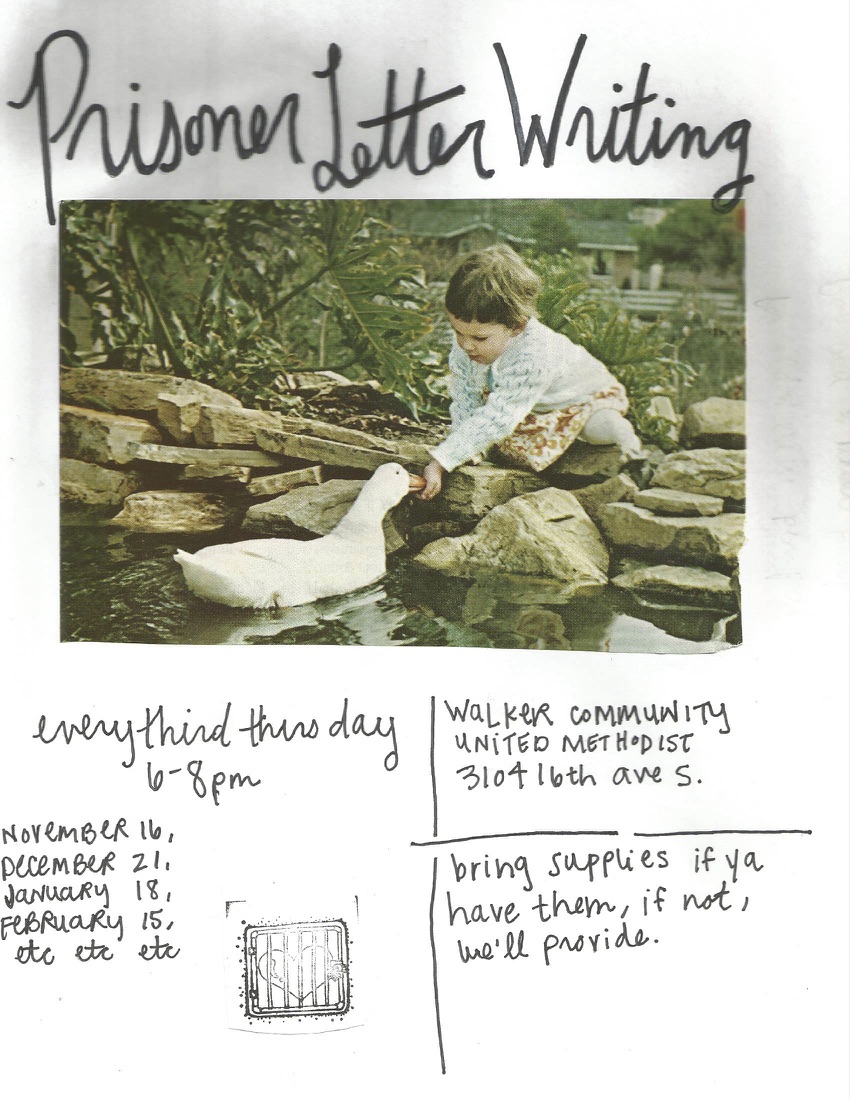
Third Thursdays
Walker Church
3104 16th Ave S
6:00 PM
Prisoner letter writing night is back! The third Thursday of every month at Walker Community Church from 6-8pm.
In hosting this event we will provide, monthly, a prisoner to write to who is generally referred to as a political prisoner, particularly/often around the time of their birthday in order to send them well wishes and cards—or if they’re undergoing tough times, etc.
This month we’ll be writing to those who were locked up as a result of the Ferguson protests in 2014.
Feel free to write in advance if you’d like, just know that sometimes the addresses are subject to change and it’s always good to check the address in advance.
However, we’re also hoping that this letter writing night will encourage folks to come prepared to engage in sustained relationships with folks locked up. We’re open to providing names of folks to write in the event that someone doesn’t have a pen pal but wants one.
Bring yr own envelopes and stamps if ya have em, if not, we’ll provide. Additionally, we have a p.o. box if you feel uncomfortable giving your home address as the return.
♥
until all are free,
NMPSP
Anonymous submission to Conflict Minnesota
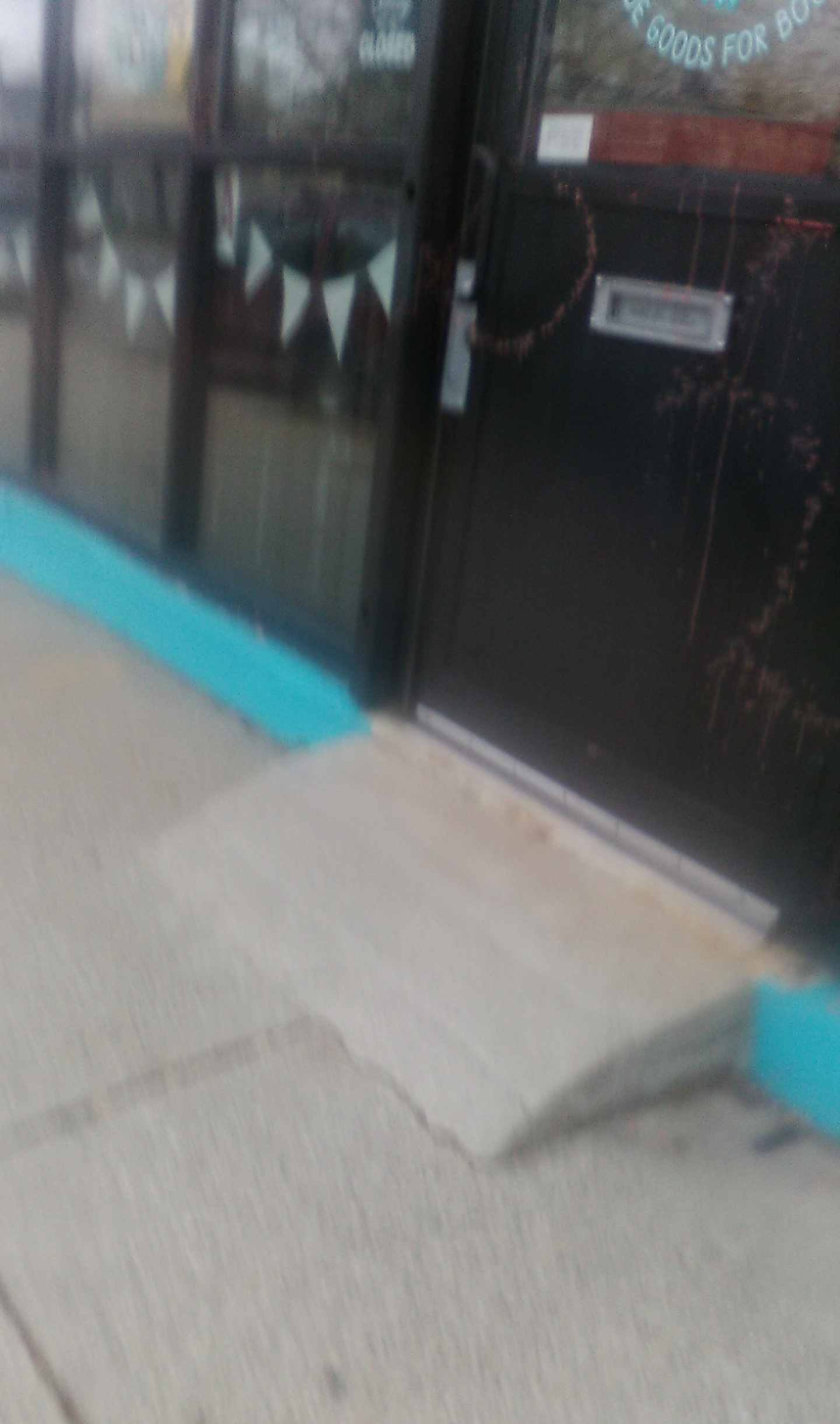
Hi y’all! Hope you all had an extra spooky/scary/witchy/wild Samhain/Halloween last night. Occupied south Minneapolis sure did! For all 500 or so people who were there last night this will be kinda dull and mild retelling of what went down last night.
It all began as the sun set around 5:18 pm. 500-1000 people gathered in south Minneapolis to celebrate the end of a season and the coming of a new darker one. As people gathered in Powderhorn Park, cops immediately attacked the super spooky crowd, but because of everyone feeling super empowered in their Halloween costumes the crowd repelled the attack and lit up a couple cop cars in short order. Families and friends were seen dancing around the burning cop car hand in hand laughing and gigglling.
Following that celebration the crowd now numbering at least 10,000-50,000 decided spontaneously and without leadership to go after all of the naughty gentrifying businesses in that neighborhood. Paint was hurled using simple garden pump spray tanks filled with house paint, water and paint thinner, which can be easily procured from local hardware stores free of cost. In total 4 yuppie coffee shop windows and several bus stop adverts for real estate brokers were filled with beautiful Halloween paint.
A comrade in the crowd wearing a super cute Demogorgon Stranger Things costume was quoted as saying “everyone should attack gentrifying businesses in occupied south Minneapolis it’s fun easy and good for the community.” 😍
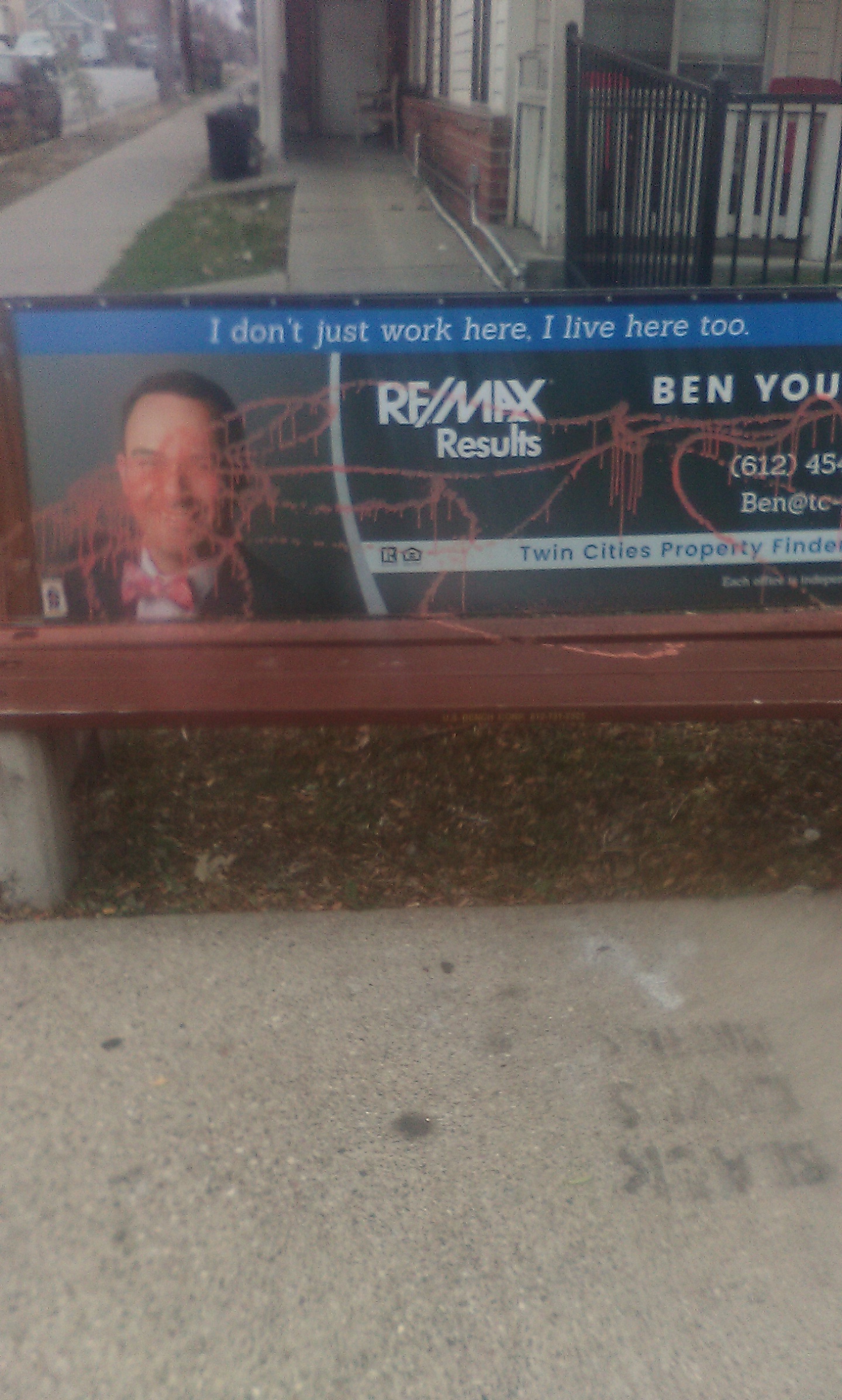
Anonymous submission to Conflict Minnesota

This was spotted in the MPD Union’s parking lot the weekend before Halloween.
Fuck Kroll.
Fuck 12.
May we end the MPD’s reign of horror and the so-called “union” that protects the killer cops who terrorized our streets. Much love to those who continue to resist in every way possible.
Anonymous submission to Conflict Minnesota

Wednesdays, December 6th, 13th & 20th
Boneshaker Books
2002 23rd Ave S
6:00 PM
Now is the latest text from the Invisible Committee, known for their infamous book The Coming Insurrection and its follow-up To Our Friends. A new critique from the anonymous collective that establishes their opposition to the world of capital and its law of labor, addresses current anti-terrorist rhetoric and the ferocious repression that comes with it, and clarifies the end of social democracy and the growing rumors of the need for a coming “civil war.”
Anonymous submission to Conflict Minnesota
This coming Wednesday, the alt-right is bringing Lauren Southern back from a failed hate flotilla in the Mediterranean to our backyard to spew her xenophobic garbage at the Willey auditorium. University of Minnesota president Eric Kahler has decided the best way to respond to stickers depicting ovens from The Right Stuff and flyers from violent white nationalists Identity Evropa, not to mention the incidents this past spring with swastikas appearing on campus by bringing a white nationalist pseudo-celebrity to campus.
We already knew the administration of this university didn’t give a shit about the safety of their non-white students and only sees its students as tuition payments, but this really takes the cake. It’s only fitting that a land grant university built on stolen Lakota land that supports prison labor would give a platform to overt white supremacy under the guise of “freedom of speech.” I’m sure that same freedom of speech applies to the students who have been met with a massive police presence every time a protest takes place on campus. I’m sure Danger Collective or Whose Diversity or Black Lives Matter would be given the same treatment by our oh so fair and balanced University of Minnesota Police Department. But I digress.
This is a call for an open ended anti-fascist bloc on Wednesday, October 25th [The speaking event is 7pm at West Bank Auditorium]. It’s encouraged that you do not arrive alone. Come with a close friend or better yet an affinity group. Take steps to protect your identity from the State and the expected presence of alt-right and alt-lite livestreamers who will surely be taking video footage to single people out for doxxing after the dust settles. This can mean any number of things from altering your appearance to covering your face. Use what makes you feel the most comfortable and more importantly, safe. Keep in mind that while on U of M campus you can assume that surveillance cameras will be everywhere. News media cameras aren’t your friends either. And as much as we all love Unicorn Riot, our enemies watch their stream too. They can (and will) find you there and if they care enough try to harass you. While online harassment might not intimidate you, keep in mind who else might be at risk if your security is compromised. Violent white supremacists and fascists typically go after the most marginalized for their acts of violence. Anti-fascism after Charlottesvile cannot afford to put any of our comrades in danger. (There are more detailed write ups available on counter-surveillance practices and security culture that can be found elsewhere.)
As anti-fascists in the Twin Cities we acknowledge that we fight on stolen land. We stand against white supremacy, patriarchy, homo- and transphobia, hatred of migrants, and the exploitation of the proletariat. We stand in uncompromising solidarity with all anti-fascist combatants worldwide in the struggle against capitalism and white supremacy. We intend to win.
– some friendly neighborhood anti-fascists
Anonymous submission to Conflict Minnesota
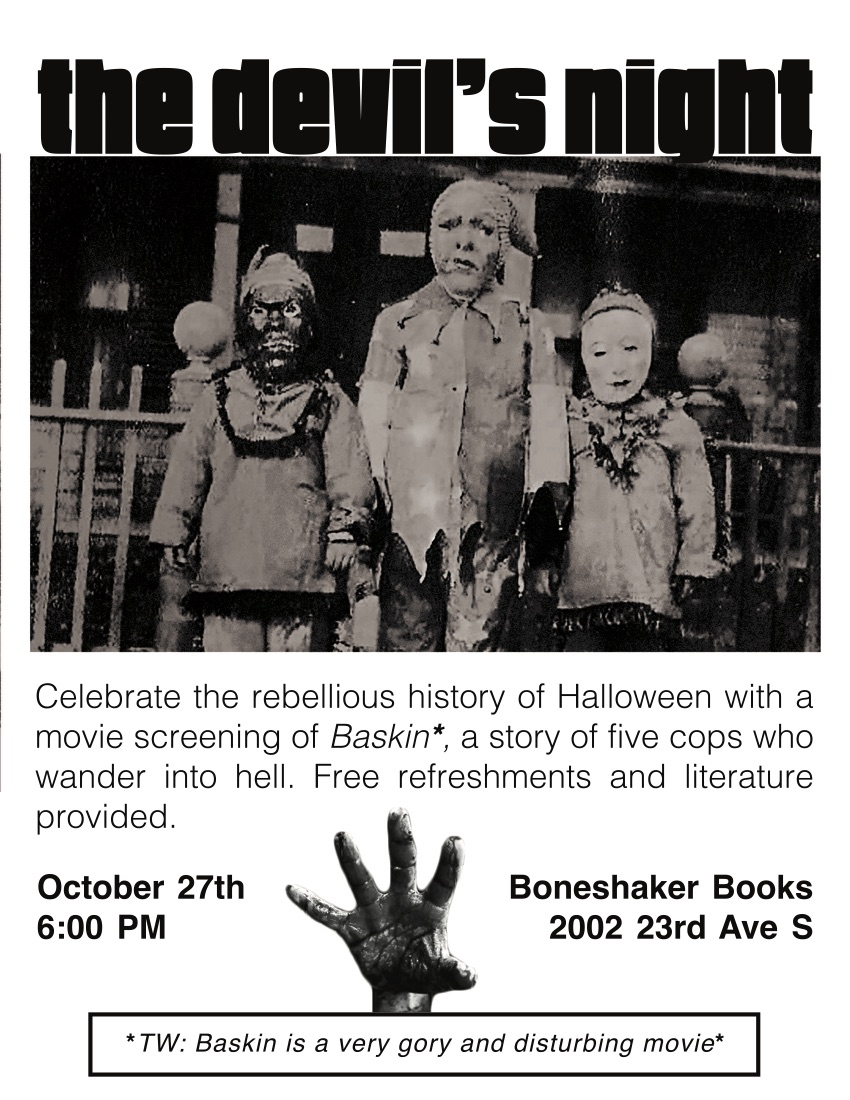
Friday, October 27th
Boneshaker Books
2002 23rd Ave S
6:00 PM
Come celebrate the rebellious history of Halloween with a movie screening of Baskin*, a story of five cops who wander in to hell.
Free refreshments and literature provided.
*TW: Baskin is a very disturbing and gory movie.
Anonymous submission to Conflict Minnesota
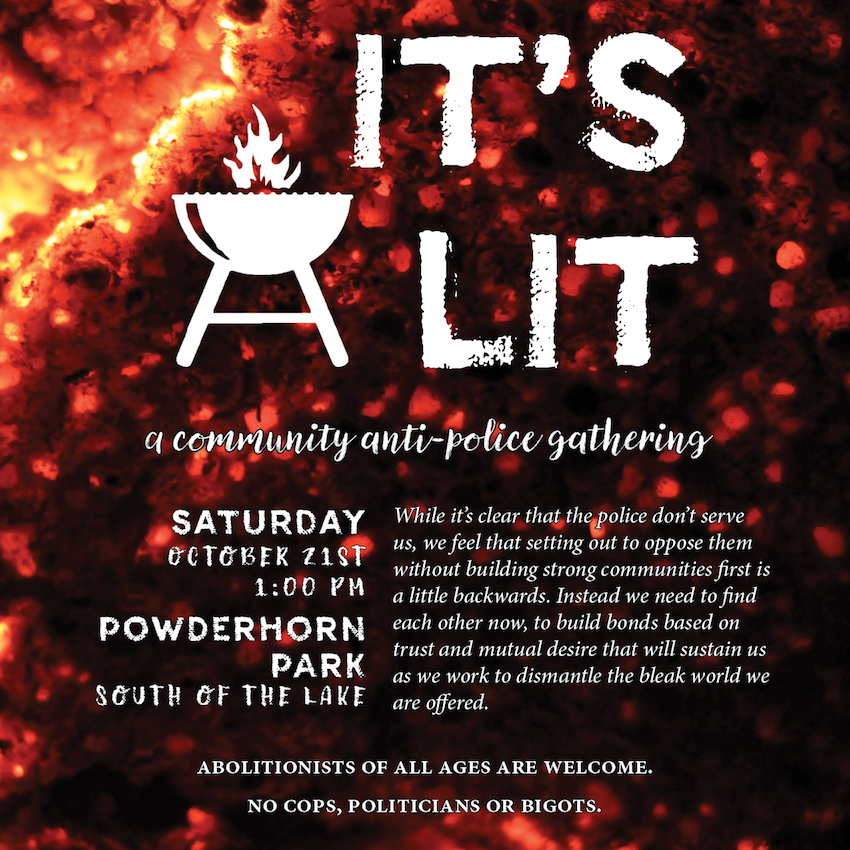
Saturday, October 21st
Powderhorn Park
South of the Lake
1:00 PM
It’s obvious that the police don’t serve us, and never could. The very idea is like trying to cure a headache with a hammer. Many have worked together over the past years to push back against these modern day slave-patrollers, and have been met with varying degrees of success. However, we can’t help but feel that setting out to oppose the police with the hope of building strong communities after they have been abolished is in some ways a little backwards. Instead we need to find each other now, to build bonds based on trust and mutual desire that will sustain us as we work to dismantle the bleak world we are offered. Otherwise any oppressors we manage to drive off will eventually be replaced by a new class of managers eager to represent, restrain, and ultimately repress us.
So we are throwing a picnic. The grill will be roaring and the lit table will be, uh, lit… but most of all we are excited to meet and talk with each other. We’ll have a good amount of food for both carnivores and vegans. If you are able please consider bringing something to share or a donation so we can make this a regular thing once it gets warm again, but of course nobody needs to contribute if they can’t.
Abolitionists of all ages are welcome.
No cops, politicians or bigots.
Anonymous submission to Conflict Minnesota

We remember Scout Schultz with love in our hearts and fiery passion for continuing their work.
Scout’s murder was premeditated by the violent policing apparatus that operates on our campuses and is enabled by liberal institutions in the name of “safety”. Let us be clear, there can be no safety at our universities while there is a publicly-funded, armed gang that roams our campuses providing security to fascists, protecting rapists, harassing and killing queer, disabled, indigenous folks, and targeting people of color at large. Our campus lies on stolen native land, and as young, queer radicals we stand in solidarity with the struggle of Scout Schultz and their comrades in fighting for communities and space free from the brutalizing capitalist security apparatus that binds us. Through community self-defense and mutual aid, we’re building the networks of support and resistance that enable us to fight back. Minnesota nice is for comrades—not cops and their sympathizers.
Rest in power Scout. This ain’t over.
Please share and contribute to the legal fund for those arrested protesting Scout’s murder.

Anonymous submission to Conflict Minnesota
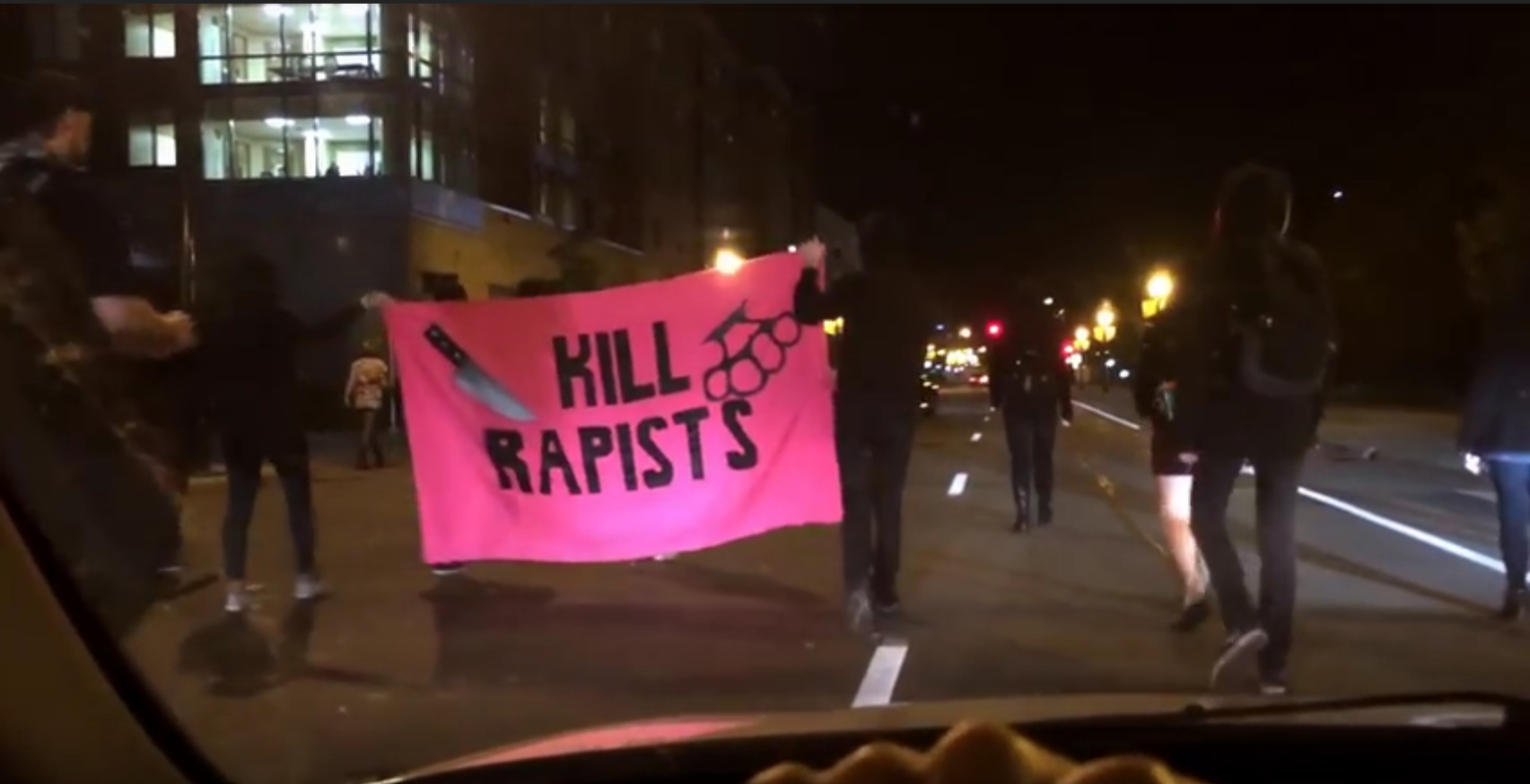
Here’s the thing: frats are a very real and material expression of systems of destruction—from white supremacy and heterosexism, to toxic masculinity inspired by patriarchy, to the elitist classism bred by capitalism. All across the nation students & neighboring communities live under the blight of fraternities, which brings scores of racist and homophobic crimes, endemic sexual violence and a squandering of resources by the elite. Despite many recent news stories including frat boy intervention into an investigation of a serial rapist in Sig Ep, a disgusting leaked commentary on the Bachelor TV show by Delta Chi, and the suspension of Delta Upsilon involving multiple rapes, UMN invests in a milquetoast “We all belong here” campaign and continues to support Greek Life by showering them in money and resources, all the while claiming the need to raise tuition. Usually the frats recruit without question, but not this year. Danger Collective held a vigil turned protest at the start of the chapter tours. Graffitti and stickers have appeared throughout dinkytown and frat row. And finally we took the streets on September 7th during Fraternity Rush Week for a good ole fashioned dance party.
30 to 40 folks gathered near frat row, ready to show the boys how to throw a real banger. Our party decorations included flares, a sparkly pink “KILL RAPISTS” banner imploring bystanders to connect with the rage that thousands of survivors feel, and our middle fingers. We casually strolled onto University Ave, chanting “fuck frats!” and “anytime, any place, punch a rapist in the face!” Our voices were accompanied by a marching band, cuz what good soirée is complete without a brass section?
Frat boys stared on dumbfoundedly as their walkways were redecorated with slogans ranging from “fuck frats” to “kill frat boys.” Campus was beautifued with circle A’s and copious amounts of paint. While some folks joined from the sidewalk, crust punks cheered us through dinkytown as they realized their spanging couldn’t compete with the masked up group shouting “fuck the frats!”
So… this happened tonight in Minneapolis pic.twitter.com/amylZkVBet
— Grant Simons (@GrantSimons2) September 8, 2017
Like at any good, rowdy party the cops showed up eventually. We quickly let the cops know how much of a party foul they were committing. Middle fingers flew and shouts of “fuck 12” greeted the berries of the cruisers. Bystanders may be confused and think we had planned this “police escort,” but let’s clear that right up: fuck cops. We want them gone just as much as we do frat boys. The two “brotherhoods” stand for the same things: rape culture, heterosexism, patriarchy and white supremacy. The only real difference is one group’s uniform is salmon and not navy (but god knows neither group has any worthwhile fashion sense).
Like all good things in life, the festivities did have to come to an end eventually. We quickly dissolved into the night, hopefully scaring a few dumbass freshman out of rushing a fraternity, inspiring a few phonecalls to daddy’s lawyer, and having taught them that there are better ways to make friends than paying for them (namely not being a sexist, racist, or homophobic slice of wonder bread).
No space exists for racist, sexist, homophobic and xenophobic frats. These parasites are not welcome here & we’ll continue shaking up the block until the pests have been extinguished.
From Nightfall
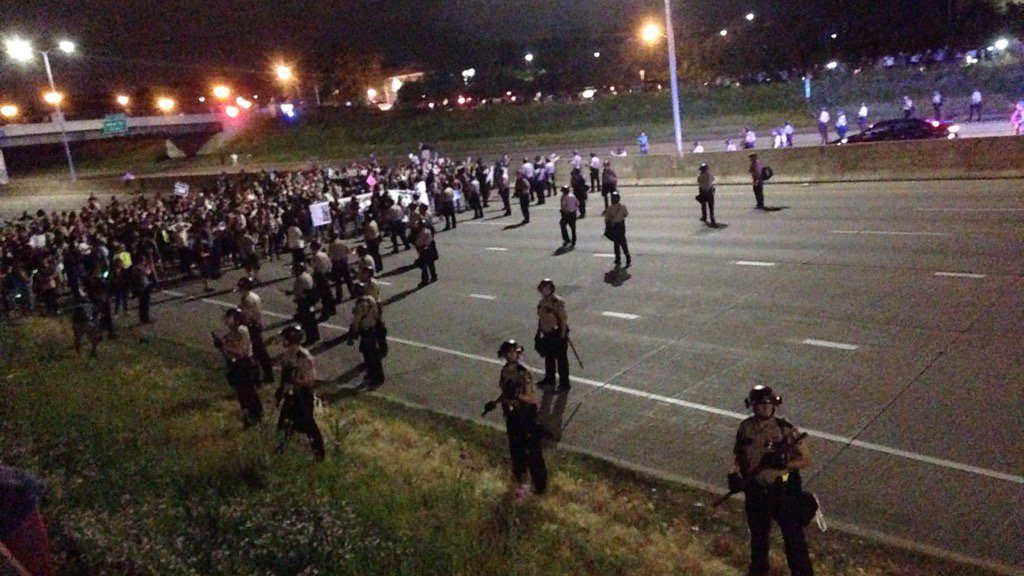
On June 17th, 2017 Officer Jeronimo Yanez was let off the hook by a majority white jury after murdering Philando Castile in cold blood. Obviously, the verdict was devastating, cruel and absolutely absurd. Most of all, though, it was unsurprising. That night over two thousand people took to the streets in the Twin Cities. Tensions were high and so was energy from the growing crowd. Young people came out by the hundreds, clad in masks and armed with anger. Earlier in the day, on a video posted to social media, Philando’s mother Valerie Castile tore in to the verdict and the police:
“They murdered my motherfucking son with his seat belt on. So what does that say to you? Now they got free reign to keep killing us any kind of way they want to. So I just want to say one thing to everybody out there, I don’t give a fuck what you do. Do what your heart desires… Fuck the police!… I hope that mother fucker die tonight.”
And yet, as in demonstrations time and time again before that night, a somewhat small group of Black Lives Matter organizers led the massive crowd in a winding route around the city of St. Paul and ultimately, via an orchestrated effort, onto Interstate 94. Police, in communication with organizers, quickly re-routed traffic to flow far around the people standing on the highway. During the march, liberal-minded activists and their dutiful ‘white allies’ shouted at and shamed people expressing their anger through graffiti, and in some instance even attempted to turn them in to the authorities.
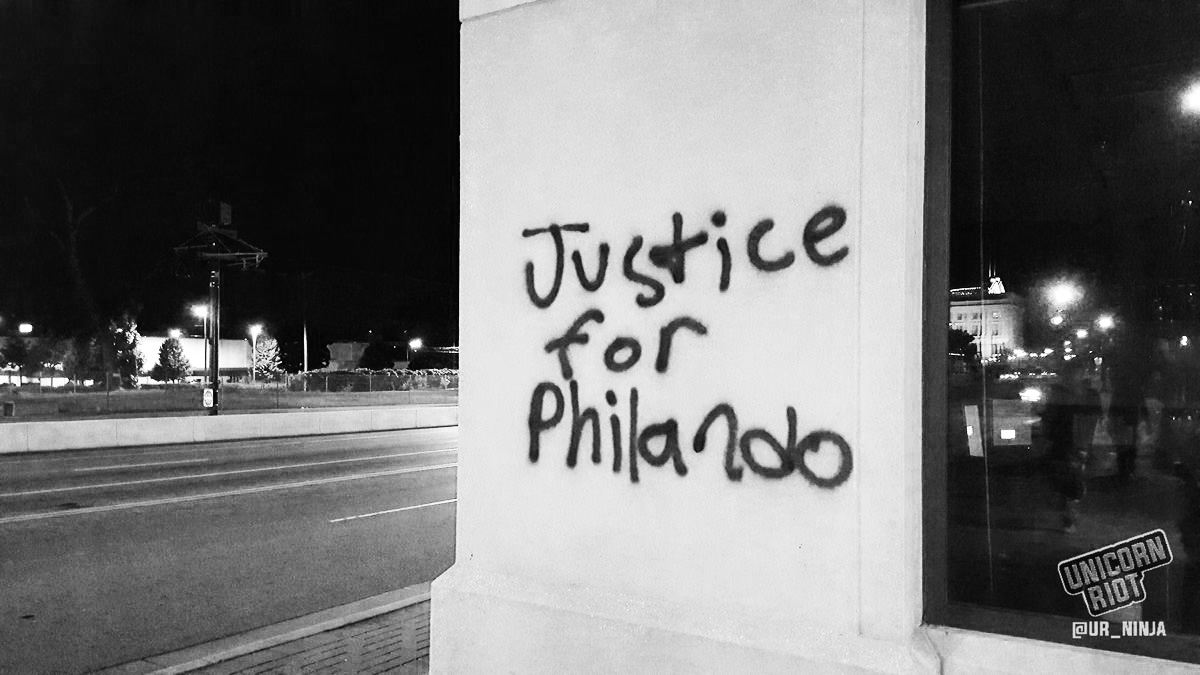 Accusations of “violence” flew, along with claims that “that’s not what this is about,” even after Valerie Castile explicitly called for people to express their anger in whichever manner their heart desired. People donning masks in order to avoid further police repression and information doxxing by the far-right were called “cowards” and “instigators”. It almost seemed like these people had forgotten that a man’s life was taken by the state, and that earlier that day it had been made clear that officers who do the same thing in the future will not be punished. But somehow writing on a traffic sign to remember and avenge Philando Castile is considered “violence”.
Accusations of “violence” flew, along with claims that “that’s not what this is about,” even after Valerie Castile explicitly called for people to express their anger in whichever manner their heart desired. People donning masks in order to avoid further police repression and information doxxing by the far-right were called “cowards” and “instigators”. It almost seemed like these people had forgotten that a man’s life was taken by the state, and that earlier that day it had been made clear that officers who do the same thing in the future will not be punished. But somehow writing on a traffic sign to remember and avenge Philando Castile is considered “violence”.
At the end of the night, as the crowds trickled out and went home, police moved in and arrested 18 people. The police were careful not to let crowds gather on the pedestrian bridge or along the side of the highway, from where volleys of rocks and fireworks seemed to originate last July when I-94 was first shut down following Philando’s murder.
The State should consider itself lucky that the city was not in flames after the verdict came out. There is a process of silencing that is occurring that is enacted not by the police departments or National Guard but by the very organizers of such rallies as well as some of the attendees. One in which a young person who fears for their life in the face of police violence is held to unrealistic and ahistorical standards of respectability towards public property and corporate shop windows. Where the dispossessed are still expected to take orders from the wealthiest and loudest non-profit voices. One where they are commanded to politely ask the slave owners to give up their plantation.
The marching, the signs, and the chants aren’t enough. They never were. It’s time to put the ‘peace police’ to rest, and to make the State fear our strength instead of re-routing traffic for us. The white supremacist police institution of the United States has a vested interest in getting away with shooting black folks, and it is clear that until it faces consequences for its actions it won’t stop killing.
From Nightfall

The lake formerly known as Calhoun is officially restored by the city to its original Dakota name, Bde Mka Ska. A sculpture which capitalizes on the pain of indigenous genocide to produce heady conceptual art aimed primarily at non-Natives is destroyed following widespread condemnation, with the offending museum promising to hire Dakota consultants in the future. Based on these incidents alone one could argue, and indeed some have, that colonialism in Minnesota is fading away. Yet at the same time, Hennepin County Sheriff’s Office personnel display remarkable brutality in assisting their North Dakotan counterparts and the National Guard in attacking water protectors at Standing Rock, some of whom are direct descendants of Dakota who were displaced from what became Hennepin County by the predecessors of our modern Sheriff’s Office. Meanwhile, Fort Snelling, once used as a concentration camp for the Dakota prior to their expulsion from Minnesota, is used by ICE as a pre-deportation detention center for immigrants, many of whom are of indigenous Chicanx heritage.
What can we make of these contradictions? Are we inching our way forward bit by bit, slowly excising the cruelty demonstrated by Trump and the oil companies from a wider American project that at its core tends towards ever-increasing degrees of freedom for all? Or do recent concessions made by colonial institutions, concessions that come for the most part in the realm of the symbolic rather than the structural, function primarily to reduce pressure on the material day-to-day functioning of colonialism? There are no universal answers to these questions, and we certainly aren’t suggesting forsaking symbolic and cultural arenas of struggle, but is important to examine the legacy of the institutions that are now paying lip service to decolonization. When we do so it is clear that these institutions, whether public or private, only ever act to preserve their own existence, an existence that is founded upon Native genocide. As such, the only truly decolonial course of action that the city, the police, or the museums could ever undertake is the only one that they never will, the path leading to: their own self-destruction.
Europeans passed through this land intermittently from the time when Father Louis Hennepin first kicked off a long tradition of bullshit and deception by chronicling fantastical beasts and barbarous savages on his 1680 journey down the Mississippi, but it wasn’t until 1805 that America established a permanent presence here. By that point the U.S. had realized that all-out war against every indigenous nation on Turtle Island at once was a prohibitively costly proposition, and so it turned to more subtle methods of fulfilling its genocidal expansionist fantasies, methods it has been refining ever since. Zebulon Pike was commissioned to negotiate a treaty to give U.S. claims of sovereignty over the area a veneer of legitimacy. Like practically all subsequent treaties between the U.S. and the Dakota, including those of 1833, 1837, 1851, and 1857, this treaty was made with a handful of Natives who had little authority to speak for anyone beyond their immediate kin, under threat of violence, and lubricated by copious amounts of government-supplied liquor. The paltry payments guaranteed by these treaties in return for the Dakota forsaking much of their lands, and with them their ability to live their traditional lifestyle, were delivered late, if at all, and the government made little attempt to keep its subjects from violating the treaties by settling on land reserved for the Dakota. At the same time the government used resistance by Natives angry over treaties not being honored, as well as by those who had never recognized the treaties to begin with, as justification for voiding the treaties and moving in with force to steal even more land.
These offenses, and the havoc they wrought on the Dakota’s ability to live in their traditional way as they had for centuries, caused tensions to come to a head in 1862. In August, with their people starving, a group of Dakota confronted Indian Agent and State Senator Thomas Galbraith and trader Andrew Myrick, one of many whites who had gotten rich siphoning off treaty payments guaranteed the Dakota, demanding the food and supplies owed them. Galbraith refused to distribute the food, and Myrick reportedly said “if they are hungry, let them eat grass.” Three days later Myrick was found dead, his mouth stuffed with grass. Dakota across the state rose up, destroying multiple settlements in an attempt to drive the invaders from their land once and for all. Major victories were won by the Dakota at New Ulm and Birch Coulee, prompting Governor Alexander Ramsey to petition President Lincoln to mobilize troops in order to “exterminate or otherwise drive the Sioux forever beyond the border of the state.” Lincoln granted Ramsey’s wish, lending the colonizers a large advantage in numbers which led to a decisive victory at the Battle of Wood Lake along the Minnesota River in September, at which U.S. troops were commanded by Colonel Henry Sibley, another Minnesotan who made a fortune stealing treaty payments owed to the Dakota, for whom parks, schools and counties across the Midwest are named. Following their surrender, 38 Dakota warriors were executed in Mankato on spurious murder charges, and a bounty of $25 per scalp was placed upon all Dakota, including children. The majority of the Dakota were rounded up into a concentration camp at Fort Snelling and forced to endure the harsh winter with inadequate supplies, leading to the death of hundreds. Following this they were exiled to surrounding states, although some eventually returned to Minnesota to pick up the pieces of their lives as best as possible despite the constant threat of colonial violence.
The centrality of these events to the continued existence of the Minnesota we know today cannot be overstated. The twin industries which built the economy of the state, logging and mining, were only possible because of the removal of the Native population, and the destruction wrought by these practices guaranteed that even once the industries moved on the reclamation of these lands and the traditional life-ways entwined with them would be impossible. Furthermore, Minnesota’s modern economy, having largely shifted away from timber and mining, is still completely founded upon Native genocide. For example, the Mayo Clinic and the Walker Art Center, juggernauts within their respective fields that have positioned Minnesota as a leader in medicine and the arts, were both founded by active perpetrators of genocide.
William Mayo worked as a doctor for the U.S. military during the Dakota War. After the execution of the 38 at Mankato, Mayo stole the body of Maȟpiya Akan Nažiŋ, one of the Dakota warriors, and used it to teach anatomy and surgery to his sons, who later became his business partners in the medical practice that would evolve into the modern Mayo Clinic. The Mayo Clinic has carried on this legacy since then, reinforcing colonialism in numerous ways, such as developing multiple life-support technologies that revolutionized high-altitude flight in the mid-20th century, paving the way for subsequent colonial wars in the Far and Middle East. Even the Mayo Clinic’s more positive medical activities cannot be unentangled from the context which birthed them. For example, one of the Mayo Clinic’s specialities is in researching treatments for cancer. While it is obvious that we need such treatments, we must also remember that skyrocketing cancer rates are a direct result of the destructive colonial system of which the Mayo Clinic is an integral part. The Mayo Clinic’s perfection of expensive cancer treatments serves to insulate those who are destroying our world from (some of) the consequences of their actions, allowing them to continue with business as usual. Those who can’t afford such treatments, however, are out of luck. It is no accident that Native people on Turtle Island suffer the highest rates of just about every disease linked to environmental destruction.
Thomas Walker, meanwhile, made the fortune with which he founded the Walker Art Center in timber, stripping the forests of Minnesota and sending them packing down the Mississippi en route to becoming the richest man in the state. The precious contemporary artworks, the shiny modernist building, the fancy restaurant; all of it is paid for with the blood and suffering of the Native people who lived in the forests that once covered much of this state. Even when the Walker shines its spotlight on radical art created to challenge colonialism or capitalism, the context within which it frames these works, that of a sterile gallery staffed by Target-branded museum guards, transmutes works that may have once been challenging and mobilizing into commodities for passive contemplation, neutralizing any threat that they may pose to the status quo. In light of this legacy, can we expect meaningful change to come out of promises made by the Walker to solicit Native input in the future? Or, to adapt a critique made by Dakota scholar Waziyatawin regarding the Minnesota Historical Society, will the Walker “reject the most critical Dakota voices and perspectives as insignificant and… simply use their new Dakota employees as mouthpieces to express the party line,” thereby maintaining the Walker’s authority over cultural debates in Minnesota? The answer is never wholly black-and-white, and as a non-Native I do not intend to criticize Natives who see potential in self-consciously exploiting the resources of colonial institutions for their own ends. However, as someone who has their own desires which lead towards confrontation with the colonial machine, I find it extremely important to keep this warning of Native author Zig-Zag in mind: “any discussion of decolonization that does not take into consideration the destruction of the colonial system and the liberation of land and people can only lead to greater assimilation and control. The demand for greater political and economic power by chiefs and councils, although presented as a form of decolonization (i.e., “self-government”), only serves to assimilate Indigenous peoples further into the colonial system.” Will the Walker hiring Dakota or the city of Minneapolis renaming a lake hasten their own destruction? Clearly, the answer is no. Only by working outside of the colonial system, on our own timelines using our own methods and desires, can we get closer to such a goal.
In researching this essay I drew primarily from Waziyatawin’s What Does Justice Look Like?, which outlines how Minnesota was stolen from the Dakota and lays out some possible courses of action, as well as the anonymous entry on the Dakota War in The Struggle is Our Inheritance, a compilation of radical Minnesota history. For further analysis of, among much else, the role of culture in decolonization and the potential for decolonial rhetoric to become co-opted by colonial forces, the work of Zig-Zag/Gord Hill is invaluable, particularly Colonization and Decolonization. These last two works can be found for free online.